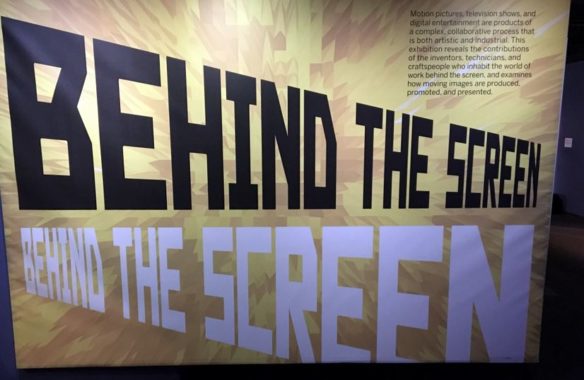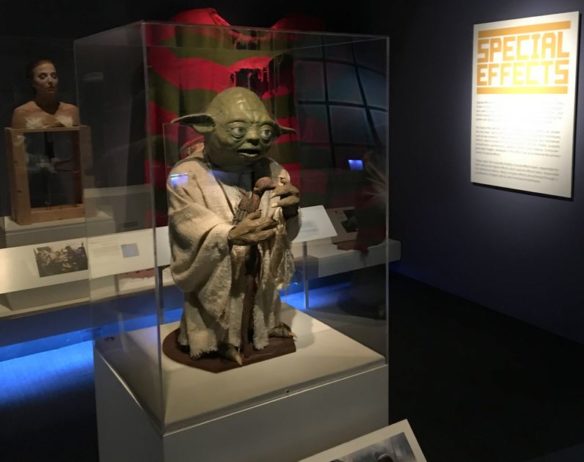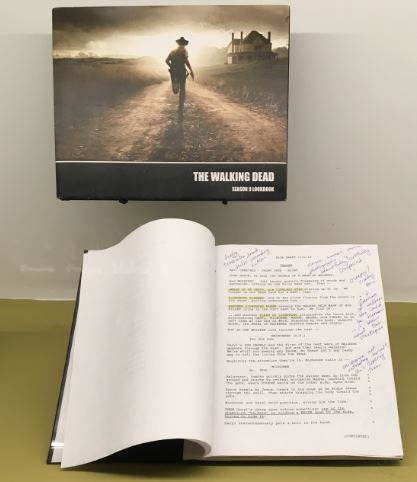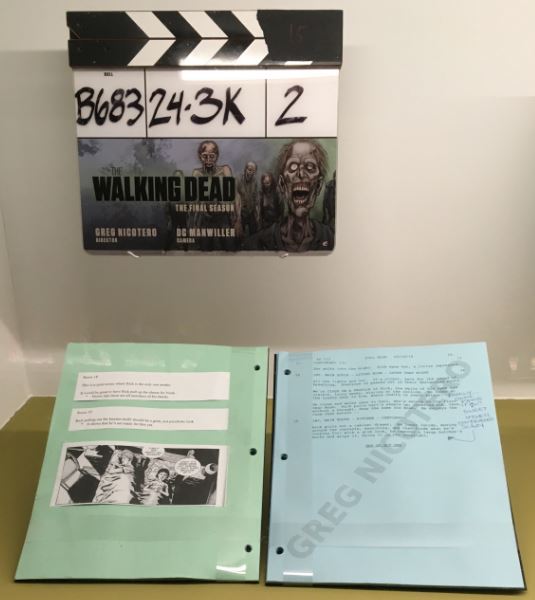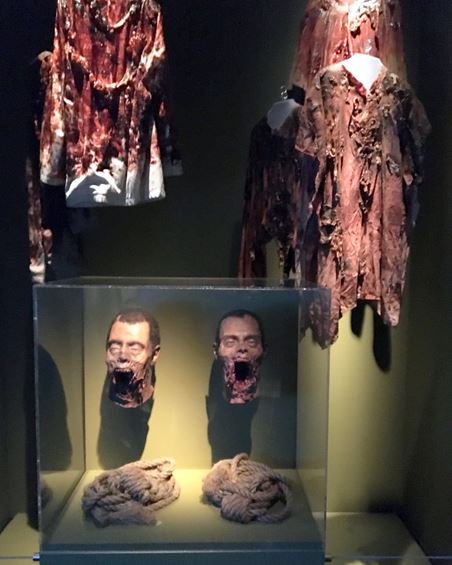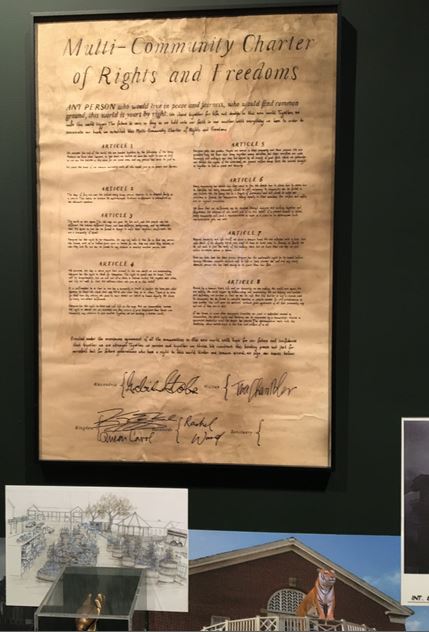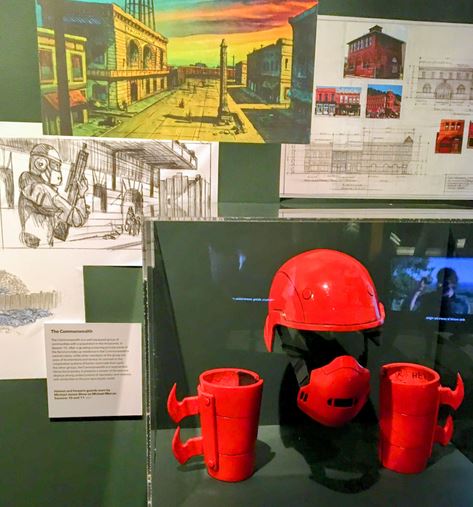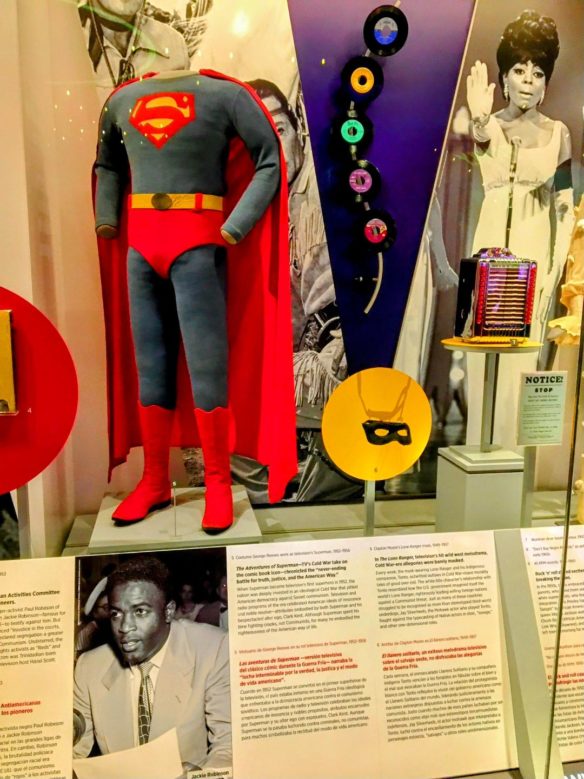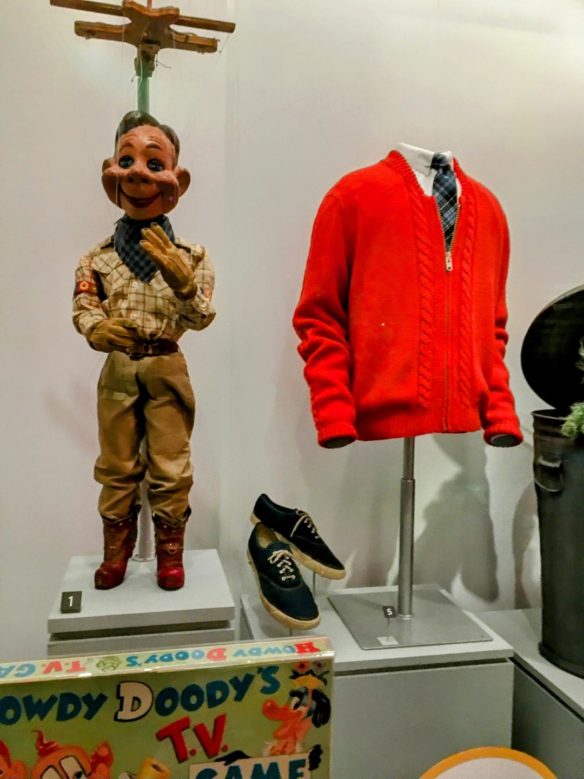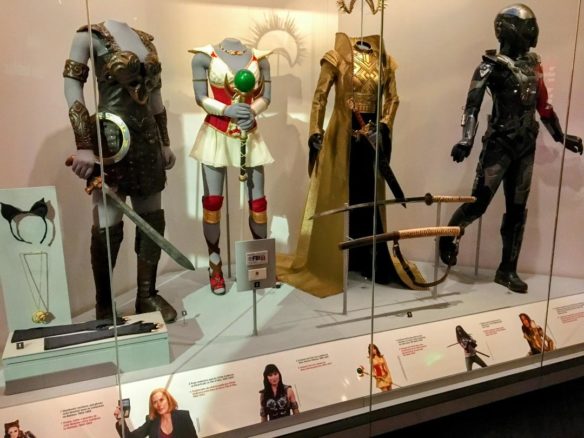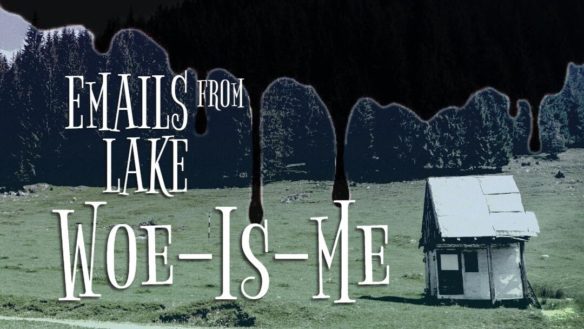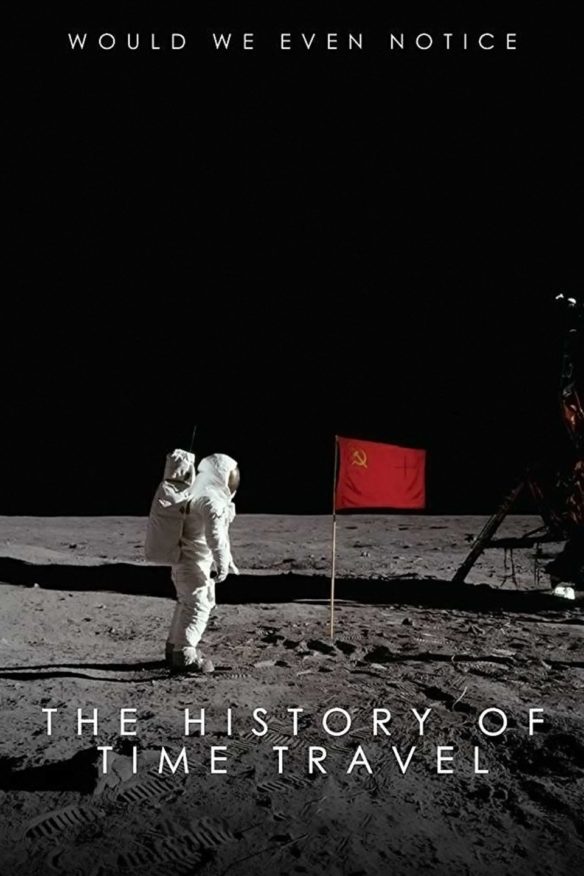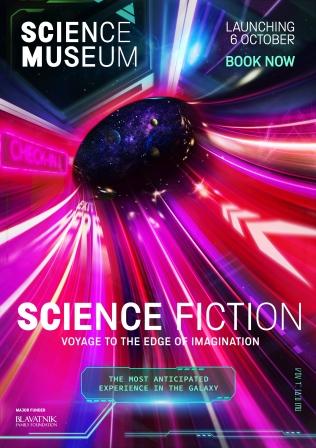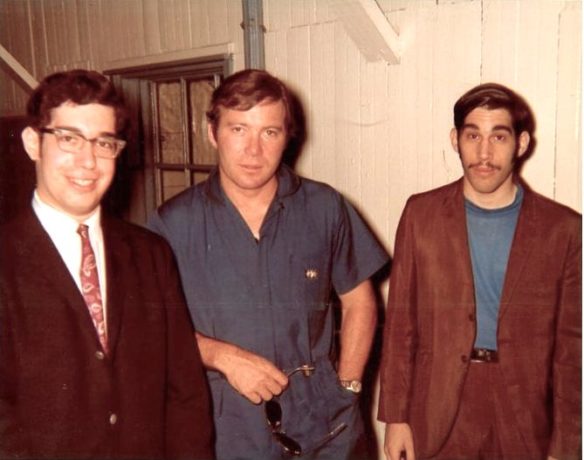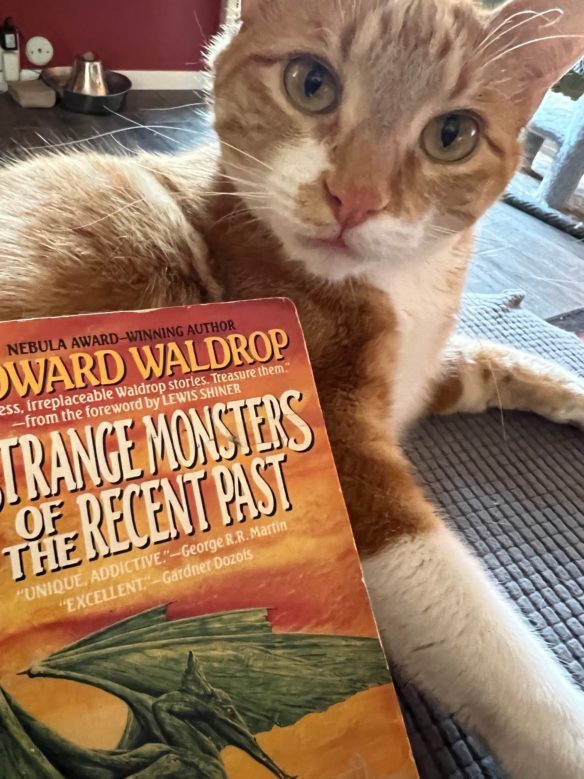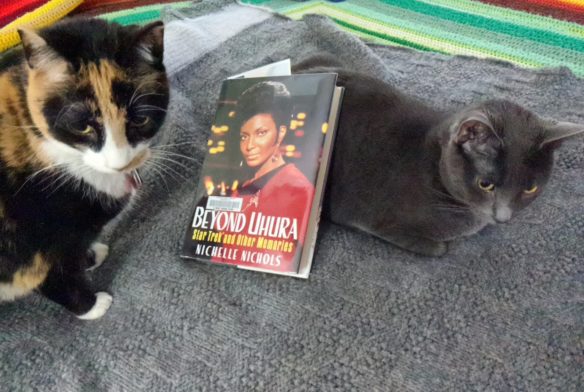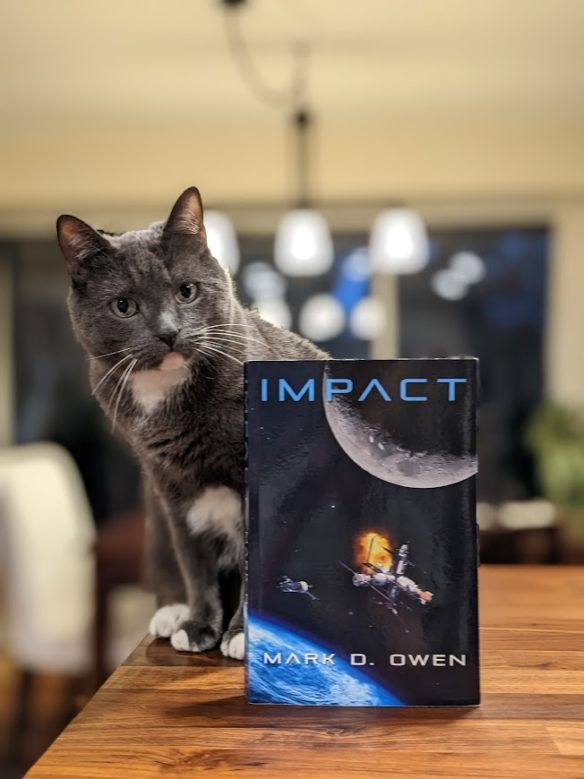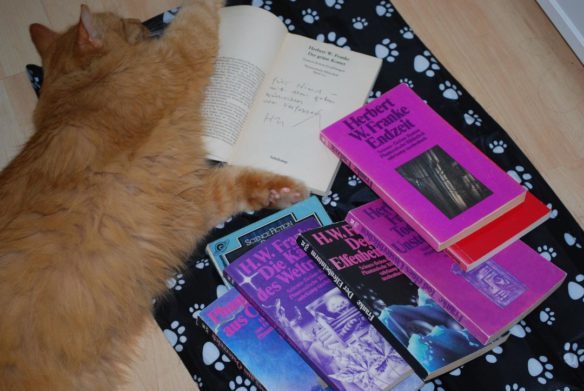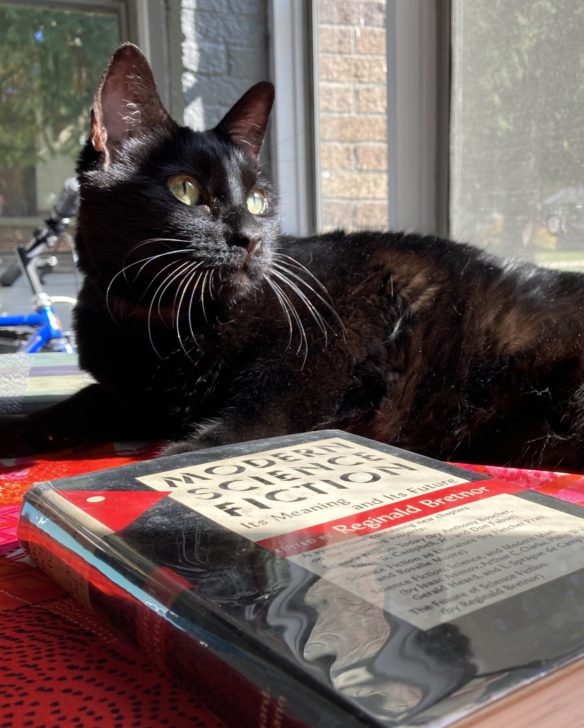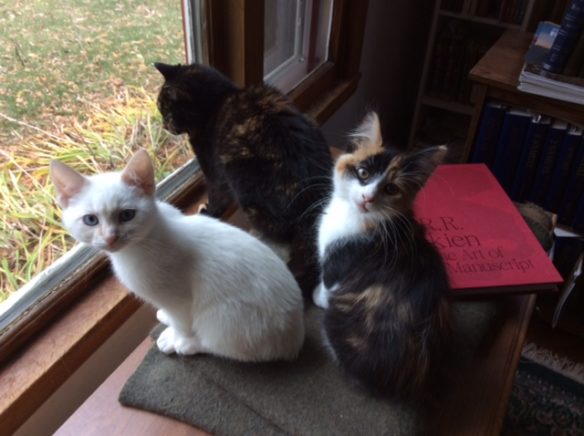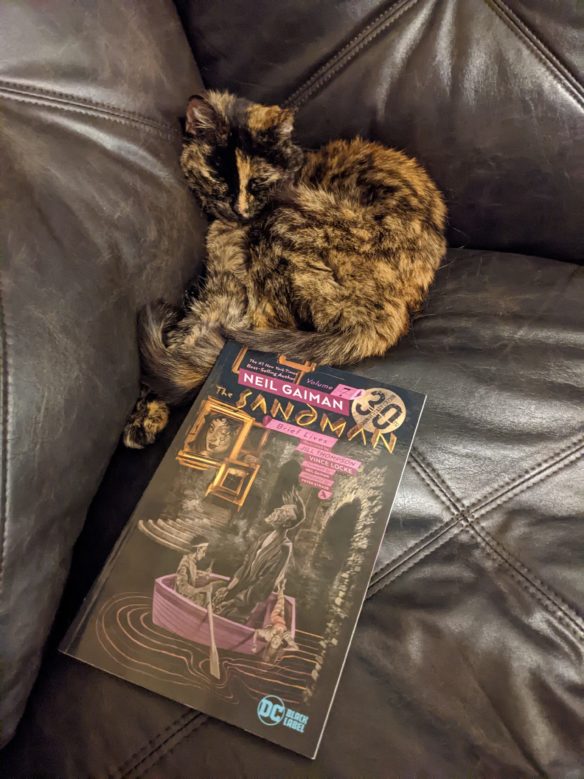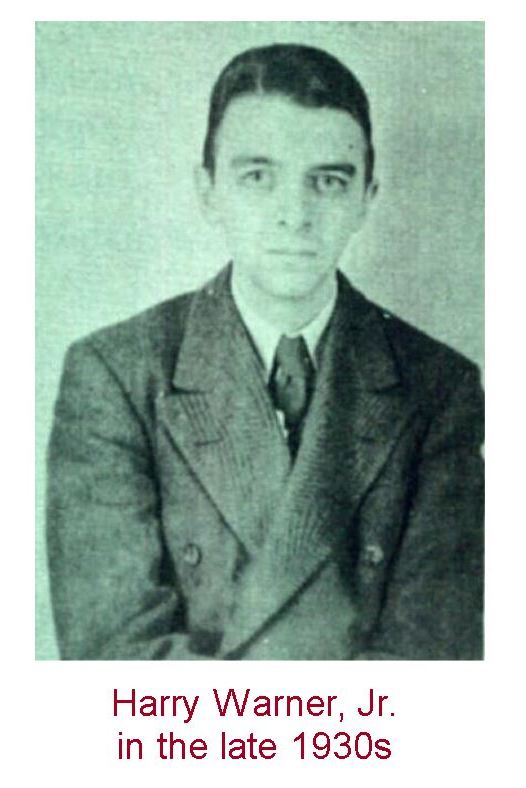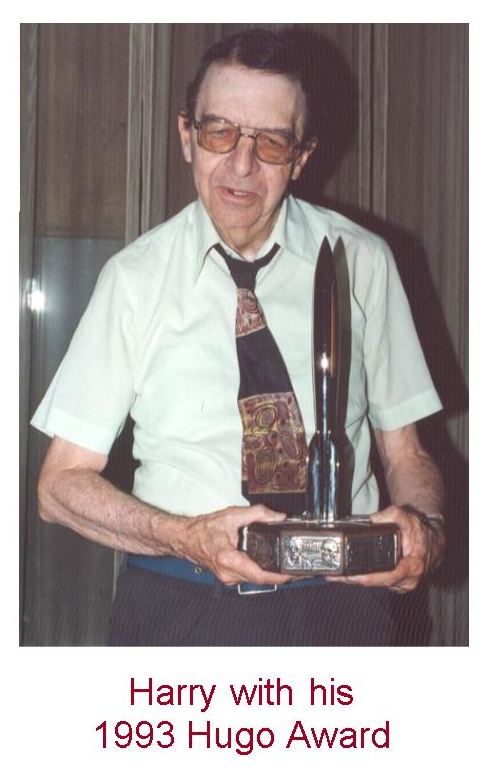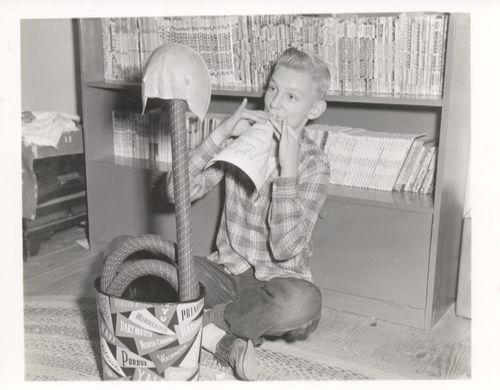(1) CHICON 8 SHARES FEEDBACK. Chicon 8 chair Helen Montgomery today published the latest of her “Messages from the Chair” dealing with some postcon housekeeping, and with a long passage apologizing for or explaining some decisions that were made. Here are two of the most significant items.
Credit for Hugo Awards Finalists (Translators and Colorists)
S. Qiouyi Lu brought to our attention the exclusion of translators’ names from the written works in the “long listed” works in the detailed results for the 2022 Hugo Awards, explaining the importance of proper credit for translators in a Twitter thread here: https://twitter.com/sqiouyilu/status/1566762259187060736. We have posted a corrected set of detailed results at https://chicon.org/home/whats-happening/hugo-awards/, in which we have included the translators for the written works and colorists for the graphic novels.
As part of the administration of the Hugo Awards, we endeavor to list all relevant creators on the final ballot presented to voters, and this includes confirming the correct ballot citations with Finalists themselves. The long list in the detailed results released after the Hugo Award ceremony is a different matter: it is required by the WSFS Constitution primarily for transparency into our processes, and has the side benefit of pointing folks to works that garnered significant community interest so they can go seek them out on their own. As noted in the detailed results, we do not vet the long list for eligibility and because the primary function of the long list is transparency into the process (which requires a table that is easy to parse), we do not list out full citations with all associated names, publishers, etc. We truncate references to all the works on the long list, listing authors for the written works, author/artist for the graphic stories, and no names at all for the Best Dramatic Presentations and magazines.
Taking into account feedback from S. Qiouyi Lu and other members of the community, we have come to understand that the work of translators of written works is as fundamental to the work as the authors, and that where one is listed, both should be. We have made corrections to the translated long list works in the 2022 detailed results accordingly. For similar reasons, we are also adding the colorists and cover artists, where they are cited, to the graphic novel listings in the 2022 long list works.
Thank you to S. Qiouyi Lu and everyone else in the community who has worked with us on this issue.Hugo Awards Ceremony
We would like to discuss two incidents that occurred during the Hugo Awards Ceremony.
First, we would like to apologize to Marguerite Kenner, Finalist in the Best Fanzine category for The Full Lid, whose name was not read aloud during the ceremony. This was simply a mis-read by our ceremony hosts, who did immediately reach out personally to Ms. Kenner after the ceremony to apologize as well.
Second, there were concerns raised online during the Best Semiprozine category presentation when the audience laughed at the discrepancy between the slide listing the names of the Strange Horizons team and what was said aloud. While we spoke with all Finalists and agreed upon the language to be used on the slides and in the presentation, we acknowledge that we did not properly explain to the audience the context and conversation around not reading out the names of everyone on the Strange Horizons team. We also did not properly support our hosts by putting them in this situation. We will be speaking to future Worldcons to pass on our advice and experience in the hope to avoid similar situations in the future.
Other items include: an apology for the original name given to the “Future Worldcon Q&A Session” (“The Fannish Inquisition”), correction of errors in Hugo Awards list in the printed Souvenir Book (names misspelled, Astounding Award 2022 winner name listed); omissions of some credits for the Hugo Awards Ceremony and Opening Ceremony; follow-up with the Airmeet team; Art Show feedback; complaints about badge lanyards; and reasons for having an electronic-only Pocket Program Guide.
(2) FIFTH SEASON RPG CROWDFUNDING. [Item by Eric Franklin.] Green Ronin has launched a Backerkit campaign for the Fifth Season RPG, using their tried-and-tested AGE system (which was also used in the Expanse RPG). “The Fifth Season Roleplaying Game”.

…You and your fellow players take the roles of members of such a community, working to overcome internal difficulties and external threats, in order to be ready when that inevitable Fifth Season comes. Are you a lifelong native of this place, someone everyone has recognized from childhood? Maybe you’re a more recent addition to the comm, someone who’s come from a distance, contributing something to the comm that makes the possibility of your secrets and past catching up to you worth it. Or perhaps you are an orogene, one who was born to sess the movements of the tectonic plates, gifted with a forbidden power to still the shaking earth and bleed heat in your environs away until frost coats everything in a perfect circle around you….
To let you know how it’s all going to work they’ve created “The Fifth Season Roleplaying Quickstart”, a free 45-page download at the link.
If you’re wondering what The Fifth Season RPG is like, you can find out right now. We’ve got a free PDF Quickstart that has an introduction to the Stillness, basic rules to play, pre-generated characters, and a complete adventure. Reading it, or better yet playing it, will give the best introduction to what The Fifth Season RPG is all about…
(3) WHERE ARE THE WATCHMEN? “Doomsday Clock moves to 90 seconds to midnight, signaling more peril than ever” reports NPR.
The world is closer to catastrophe than ever: the Doomsday Clock, the metaphorical measure of challenges to humanity, was reset to 90 seconds before midnight on Tuesday.
The science and security board of the Bulletin of the Atomic Scientists said the move — the closest to widespread calamity humanity has ever been judged to be — was “largely, though not exclusively” due to the war in Ukraine.
The scientific body evaluates the clock each January. This is the first full update since Russia’s full-scale invasion of Ukraine began last February, triggering a war in Europe and a new flood of refugees….
(4) LIVE FROM DEVELOPMENT HELL. Eva Green was cast for A Patriot, a science fiction movie about “a Border Corps captain in an authoritarian futuristic state”, a movie that’s not getting made while she and the producers are suing each other: “‘Evil’, ‘peasants’ and ‘vomit’ – Eva Green’s WhatsApp messages exude star quality” in the Guardian.
A lot of Eva Green’s success is down to her sense of unknowable mystique. This is a woman who steers clear of the celebrity circuit, who isn’t given to blurting her every waking thought on social media. Interviewers perennially struggle to get to her core. Since her breakthrough in Bertolucci’s The Dreamers almost two decades ago, Green has preferred to let her work speak on behalf of her. She is an enigma, an image on a screen upon which we can project our own feelings.
Or at least she was, because loads of Eva Green’s WhatsApp messages have been read out in court, and hoo boy!
Let’s deal with the court case briefly. In 2019, Green signed up for A Patriot, a science fiction movie that would also star Charles Dance and Helen Hunt. The film – about a Border Corps captain in an authoritarian futuristic state – was never made. When the production hit the skids, Green sued producers for her £830,000 fee (almost a quarter of the film’s total budget). And this caused the producers to countersue, claiming that the reason the film was never made was because Eva Green tried to sabotage it. She argues that she did everything that she could to fulfil the terms of her contract and denies “in its entirety” the allegation that she did not want the project to succeed….
(5) ROOM FOR DOUBT. Call Lincoln Michel a skeptic: “Maybe the Book Doesn’t Need to Be ‘Disrupted’ in the First Place?” at Counter Craft.
…In the intervening years, I’ve seen countless versions of enhanced books hyped. Last year, there were articles about how “web 3” and crypto would completely change publishing by [something something string of jargon] block chain! All the magazines publishing daily articles on Web 3 and NFTs have stopped talking about them, seemingly in embarrassment as the crypto space has been exposed as a series of Ponzi schemes. (The crypto crowd is too busy focusing on “disrupting” the legal system to keep themselves out of jail to innovate the novel, I guess.) So naturally everyone who, last year, was declaring crypto would revolutionize every aspect of life have pivoted to saying “A.I.” will revolutionize every aspect of life. And, like the tweet above, that means lots of predictions about how the book will be disrupted. (Commenters to the above tweet also suggested putting books in the “metaverse” so you can “live” books instead of read them, whatever that means…)
I’m on the record as a bit of an “A.I” skeptic. And I’m putting A.I. in scare quotes because a computer program that spits out text it doesn’t understand is not an “intelligence” really. (Renaming “software” as “A.I.” was a very clever marketing coup. People freak out when they hear an “A.I.” did something like win a spelling bee even though no one would be terribly impressed to hear a computer program with a built-in dictionary did that.) …
(6) LIKE A VIRGIN. Leonard Maltin is ecstatic about “My First-Ever Oscar Vote”.
I’ve been watching the Oscars since I was a kid, and writing about them for decades, but this year I did something I never dreamt of during all that time: I cast a vote.
Last year, I was admitted to the Academy of Motion Picture Arts and Sciences, in the At-Large category. (There is no branch representing authors, critics, or preservationists.) As awards season began it dawned on me that I was actually going to participate in this year’s Oscars.
My invitation to vote came about two weeks ago, with a deadline of January 17. As I continued to catch up with foreign-language films, indies, and documentaries I put off voting until Monday, one full day before deadline. The deed didn’t take long, as I was only qualified to cast one vote: for Best Picture.
In the first stage of the awards process, members of the Academy’s branches determine the nominees in each specialized category. Only writers nominate writers, only makeup artists nominate makeup artists, and so on….
(7) FIVE TOP CATS. [Item by Nina Shepardson.] Tor.com has an article about cats in fantasy. Given that File770 has a feature called “Cats Sleep on SFF”, I figured Filers might be interested…. “Admiring Five of Fantasy’s Best Cats” by Cole Rush.
I’ve always thought cats are the perfect companion for the bookish. You never have to put down your book to take a cat for a walk. Instead, our feline friends will curl up on our laps while we dive into our latest fantasy obsessions, as though they’re tiny, fuzzy dragons lounging atop their hoard.
While I have nothing but love and respect for dogs—whether they’re real-life canines or fictional good boys—I feel a special kind of appreciation when a fantasy story contains a cat. Below, I’ll list five of my favorite fantasy felines and briefly discuss whether they’d make good real-world pets….
(8) MEMORY LANE.
2004 — [Compiled by Cat Eldridge.] Medicine Road by Charles de Lint
Ok, I’ll admit, it is not about food, but it’s a bar which is sort of related to food, isn’t it? Ok I’m stretching things this time. I’ll admit though The Hole does have food and de Lint (with permission of course) borrowed it from Terri Windling’s The Wood Wife.
The quote this time is from Charles de Lint’s Medicine Road which involves the grown up versions of the Dillard Sisters who we last encountered in his children’s book, A Circle of Cats. Here they are folk singers touring the Southwest when they encounter the more mythic aspects of that region.
Medicine Road was one of a series of shorter novels by de Lint that were illustrated by Charles Vess which published by Subterranean Press. Seven Wild Sisters, in which we first met Bess and Laurel, who are another of his sister characters. Both are lovely books as objects and damn fine reads as well.
Here’s my chosen quote.
We’d just finished playing our first set at the Hole, in Tucson, Arizona, and were getting ready to take our break. The place was properly called the Hole in the Wall, but when we asked directions to the Barrio Historica at the front desk of our hotel, the guy with the purple hair told us everyone just calls it the Hole. He also told us that it’s a pretty much a dive, but he should see the roadhouses back home in the Kickaha Mountains. This old adobe building, right on the edge of the barrio, is like a palace compared to some of the places we’ve played in Tyson County.
And it’s trés cool, as Frenchy’d say.
You come in off the street into a warren of rooms with saguaro rib ceilings, thick adobe walls, beautifully carved oak doors, and weathered wood plank floors. It smells of mesquite and beer, cigarette smoke and salsa. The band posters on the walls advertise everything from Tex-Mex and Cajun to bluegrass, reggae and plain old rock ‘n’ roll.
But the best part is that once you’ve threaded your way through the maze of little inner rooms you come out into a central courtyard, open to the sky. Clematis vines crawl up the walls. Mismatched tables are scattered across a cracked tile floor. And there, under the spreading branches of a mesquite tree, is the stage where we’ve been playing.
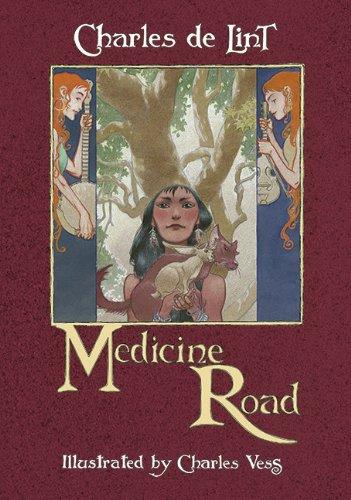
(9) TODAY’S BIRTHDAYS.
[Compiled by Cat Eldridge.]
- Born January 24, 1911 — C. L. Moore. Author and wife of Henry Kuttner until his death in 1958. Their collaboration resulted in such delightful works as “Mimsy Were the Borogoves” and “Vintage Season”, both of which were turned into films which weren’t as good as the stories. She had a strong writing career prior to her marriage as well with such fiction as “Shambleau” which involves her most famous character Northwest Smith. I’d also single out “Nymph of Darkness” which she wrote with Forrest J Ackerman. I’ll not overlook her Jirel of Joiry, one of the first female sword and sorcery characters, and the “Black God’s Kiss” story is the first tale she wrote of her adventures. She retired from writing genre fiction after Kuttner died, writing only scripts for writing episodes of Sugarfoot, Maverick, The Alaskans and 77 Sunset Strip, in the late Fifties and early Sixties. Checking the usual suspects, Deversion Books offers a nearly eleven-hundred page collection of their fiction for a mere three bucks. (Died 1987.)
- Born January 24, 1917 — Ernest Borgnine. I think his first genre role was Al Martin in Willard but if y’all know of something earlier I’m sure you’ll tell me. He’s Harry Booth in The Black Hole, a film whose charms still escape me entirely. Next up for him is the cabbie in the superb Escape from New York. In the same year, he was nominated for a Razzie Award for Worst Supporting Actor as Isaiah Schmidt in the horror film Deadly Blessing. A few years late, he’s The Lion in a version of Alice in Wonderland. Merlin’s Shop of Mystical Wonders is horror and his Grandfather isn’t that kindly. He voices Kip Killigan in Small Soldiers which I liked, and I think his last role was voicing Command in Enemy Mind. Series wise let’s see… it’s possible that his first SF role was as Nargola on Captain Video and His Video Rangers way back in 1951. After that he shows up in, and I’ll just list the series for the sake of brevity, Get Smart, Future Cop, The Ghost of Flight 401, Airwolf where of course he’s regular cast, Treasure Island in Outer Space and Touched by an Angel. (Died 2012.)
- Born January 24, 1937 — Julie Gregg. A performer that showed up in a lot of SFF series though never in a primary role. She was in Batman: The Movie as a Nightclub Singer (uncredited) in her first genre role, followed by three appearances on the series itself, two as the Finella character; one-offs on I Dream of Genie, Bewitched, The Flying Nun, Mission: Impossible, Kolchak: The Night Stalker and Incredible Hulk followed. Her only lead role was as Maggie Spencer in Mobile One which can’t even be stretched to be considered genre adjacent. (Died 2016.)
- Born January 24, 1941 — Gary K. Wolf, 82. He is best known as the author of Who Censored Roger Rabbit? which was adapted into Who Framed Roger Rabbit. It bears very little resemblance to the film. Who P-P-P-Plugged Roger Rabbit? which was written later hews much closer to the characters and realties of the film. He has written a number of other novels such as Amityville House of Pancakes Vol 3 which I suggest you avoid at all costs. Yes they are that awful.
- Born January 24, 1944 — David Gerrold, 79. Let’s see… He of course scripted the Hugo nominated “The Trouble With Tribbles” which I absolutely love, wrote the amazing patch-up novel When HARLIE Was One, has his ongoing War Against the Chtorr series and wrote, with Robert J. Sawyer, Boarding the Enterprise: Transporters, Tribbles, and the Vulcan Death Grip in Gene Roddenberry’s Star Trek. Besides his work as a novel writer, he’s been a screenwriter for Star Trek, Star Trek: The Animated Series, Land of the Lost, Logan’s Run (the series), Superboy, Babylon 5, Star Trek: Deep Space Nine, Sliders, Star Trek New Voyages: Phase II, and Axanar. Very, very impressive.
- Born January 24, 1949 — John Belushi. No, he was not in a single SFF series or film that I can mention here though he did voice work on one such undertaking early in his career that I’ll not mention here as it’s clearly pornographic in nature. No, he’s here for his brilliant parody of Shatner as Captain Kirk which he did on Saturday Night Live which you can watch here. (Died 1982.)
- Born January 24, 1984 — Remi Ryan, 39. You most likely remember as her as ever-so-cute hacker urchin in RoboCop 3 who saves the day at the end of that film. She actually had her start in acting in Beauty and the Beast at four and was in The Flash a year later. At twelve, she’s in Mann & Machine. A year later is when she’s that urchin. Her last genre undertaking was in The Lost Room a decade ago and she retired from acting not long after.
(10) COMICS SECTION.
- From Tom Gauld.
(11) JUST A SECOND. “Guns and Nonsense: Part 2” is today’s installment of Camestros Felapton’s analysis of Larry Correia’s newly released nonfiction book In Defense of the 2nd Amendment.
… It is reasonable to say that Larry Correia uses biting sarcasm, opinions differ on whether his wit is incisive and I’ve always found that what logic he uses is supremely vincible. Maybe that’s me. However, [Nick] Searcy [author of the Foreword] does focus on the central quality of Correia’s approach to examining topics of the day: mockery. Michael Moore is a large man and hence somebody who can be mocked and once mocked his opinions can be dismissed. In reality, Moore is far from infallible and his documentaries are far from flawless but engaging with them takes effort and it is so much easier to make a quick dig about over-eating and be done.
Mockery is a recurring rhetorical device in Correia’s style of argumentation and it is what his readership enjoys. He does attempt some arguments of substance but the overall thrust of his approach is not to show that an opinion is incorrect but that it is an opinion that can be mocked or dismissed. To this extent, Searcy is accurately getting to the guts of this book. The point is not to show gun control adherents as wrong but as foolish and contemptible….
(12) I SING THE LYRIC ELECTRIC. Rich Lynch took ChatGPT for a “test drive” and sent File 770 a screencap of the results.
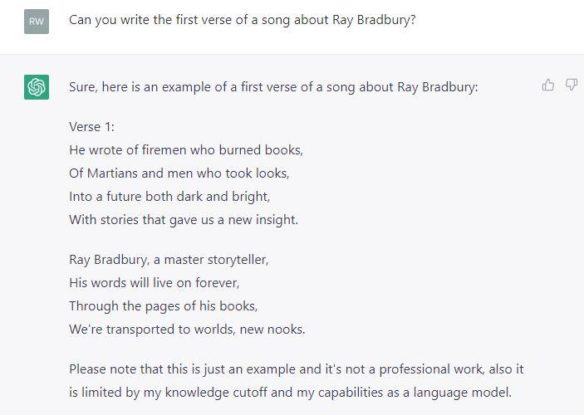
(13) DOWNLOAD THE BIG BUCKS. Meanwhile, Microsoft has moved from the test drive stage to the heavy investor stage. “Microsoft to Invest $10 Billion in OpenAI, the Creator of ChatGPT” reports the New York Times.
Microsoft said on Monday that it was making a “multiyear, multibillion-dollar” investment in OpenAI, the San Francisco artificial intelligence lab behind the experimental online chatbot ChatGPT.
The companies did not disclose the specific financial terms of the deal, but a person familiar with the matter said Microsoft would invest $10 billion in OpenAI.
Microsoft had already invested more than $3 billion in OpenAI, and the new deal is a clear indication of the importance of OpenAI’s technology to the future of Microsoft and its competition with other big tech companies like Google, Meta and Apple.
With Microsoft’s deep pockets and OpenAI’s cutting-edge artificial intelligence, the companies hope to remain at the forefront of generative artificial intelligence — technologies that can generate text, images and other media in response to short prompts. After its surprise release at the end of November, ChatGPT — a chatbot that answers questions in clear, well-punctuated prose — became the symbol of a new and more powerful wave of A.I….
(14) DRONES SHOT DOWN? “Amazon drone unit hit with layoffs as long-awaited program launches” – CNBC has the story.
In 2013, Amazon founder Jeff Bezos appeared on CBS’ “60 Minutes” to reveal a futuristic plan his company had been secretly pursuing to deliver packages by drone in 30 minutes.
A pre-recorded demo showed an Amazon-branded “octocopter” carrying a small package off a conveyor belt and into the skies to a customer’s home, landing smoothly in the backyard, dropping off the item and then whizzing away. Bezos predicted a fleet of Amazon drones could take to the skies within five years and said, “it’s going to be a lot of fun.”
A decade later, Amazon is finally starting to launch drone deliveries in two small markets through a program called Prime Air. But just as it’s finally getting off the ground, the drone program is running squarely into a sputtering economy and CEO Andy Jassy’s widespread cost-cutting efforts.
CNBC has learned that, as part of Amazon’s plan to slash 18,000 jobs, its biggest headcount reduction in history, Prime Air is losing a significant number of employees….
(15) GOOD DEED FOR THE DAY. Ready to move on from fandom? This sounds like a great substitute. “A ‘Big Night’ for Newts, and for a California Newt Brigade” in the New York Times.
…What the newts need now is a safe way to get to their rendezvous points. In many places, busy roads lie between newts and their breeding grounds. In Petaluma and other parts of the San Francisco Bay Area, thousands of newts are killed by cars each year as they try to cross these roads. The carnage in Petaluma is so severe that a group of local residents has taken it upon themselves to stop it.
For the past four years, volunteers have spent their winter nights shepherding newts across a one-mile stretch of Chileno Valley Road, a winding country road in the hills of Petaluma. They call themselves the Chileno Valley Newt Brigade, and their founder, Sally Gale, says they will keep showing up until the newts no longer need them.
On a warm, wet evening in early December, Ms. Gale and her fellow brigaders gathered to do what they do best: save newts. Wearing reflective vests and armed with flashlights and buckets, Ms. Gale and her brigaders split up into groups and began scouring Chileno Valley Road. The conditions were perfect for newts. It had just rained and the temperature was a brisk 55 degrees.
“That’s their sweet spot,” Ms. Gale said.
…On busy nights, as many as 24 volunteers gather on the road to spend their evening shepherding newts to safety.
“It’s such a huge cross-section of people, and we haven’t met a bad one yet,” said Katie Brammer, a graphic designer and newt brigade captain. Among her fellow volunteers are schoolteachers, students, naturalists, business owners and retirees.
Ms. Brammer and her husband, Rick Stubblefield, have been newt brigade captains for just over a year. They say it’s the charisma of the newts that got them hooked on helping.
“California newts are quite endearing,” Ms. Brammer said. “They hold onto your hand as you’re carrying them across the road.”…
(16) VIDEO OF THE DAY. This has been out for awhile, however, it may not have been linked here before. “Marvel Studios’ Ant-Man and The Wasp: Quantumania”. To be released February 17.
[Thanks to Chris Barkley, Andrew Porter, Michael Toman, Nina Shepardson, Cat Eldridge, Mike Kennedy, and John King Tarpinian for some of these stories. Title credit belongs to File 770 contributing editor of the day Amdrew (not Werdna).]

